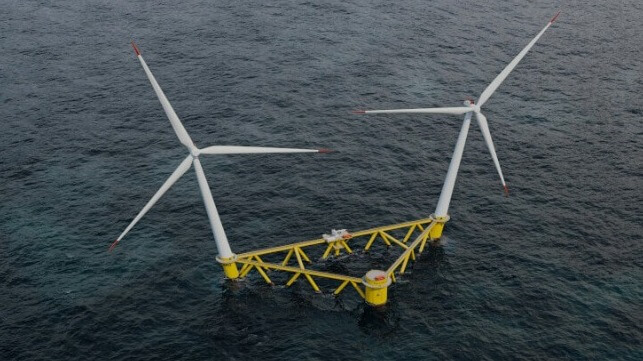Unique Twin Floating Wind Foundation Proceeding Toward Demonstration

An innovative design for a floating wind turbine foundation that holds two turbines and maximizes output is moving forward toward demonstrations for proof of concept. DNV provided the TwinWay demonstrator developed by Hexicon with a statement of feasibility. With achieving this first step in the certification process, DNV reports that it considers the TwinWay concept feasible for further development towards a full-scale demonstrator.
The intention of the TwinWay project, which will be installed and operated off the coast of Norway, is to show proof of concept for Hexicon´s floating wind foundation TwinWind. The patented concept is for a floating foundation that hosts two wind turbines and weathervanes around a single mooring point. According to Hexicon, the TwinWind design allows the foundations, rather than the individual turbine nacelles, to align with the wind. This will allow for the deployment of more turbines per sea area, increasing the energy yield per acreage, and reducing the environmental impact. TwinWind also reduces the total costs of cabling, steel, installations, and maintenance and importantly addresses a phenomenon known as “wind shadow,” a wake causing upwind turbines to reduce the wind speed for downwind turbines.
“The Statement of Feasibility from DNV is a valued milestone in our TwinWay demonstrator project,” says Marcus Thor, Chief Executive Officer of Hexicon. “After years of development, we are now progressing through the next project phase, aiming to deploy the full-scale version of our patented design for the first time.”
The unique design concept is being positioned as a cost-effective solution to realize the benefits of float wind farms. Floating wind platforms enable installation in greater water depth, allowing higher average wind speed and lower visual impact by placing the farms further offshore. They are also seen as an opportunity to increase the available area for wind farms to increase total power generation. Hexicon says that its innovative design further allows for the deployment of more turbines per sea area, increasing the energy yield per acreage.
Norway has aggressive plans to rapidly expand the amount of power generated from offshore wind. The government’s plans call for future installed offshore wind capacity to be 3 GW in 2030, 10 GW in 2040, and 14 GW in 2050.
“Norway is at the forefront of developing floating wind having had the first full scale floating wind turbine in operation since 2009 and currently has the world’s largest floating wind farm, Hywind Tampen, under construction,” says Sille Grjotheim, Director and Country Manager Norway for Renewables Certification at DNV. “Certification of innovative projects like TwinWay helps to demonstrate the performance, reliability and commercial viability of technological advances which push the boundaries of current technical and engineering knowledge.”
In November 2021, Hexicon announced that it was partnering with engineering company Worley for the engineering and fabrication of the TwinWay project. Fabrication is expected to begin in the fall of 2022 with the project deploying in 2023.
